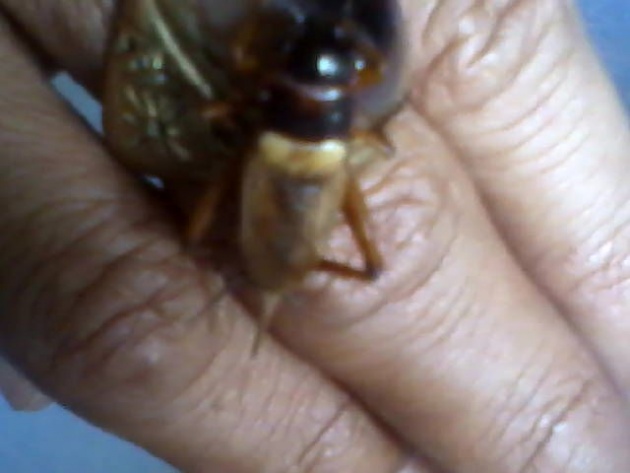CLASSIFICATION OF CRICKET

Listen to the music of nature is not the same as the sound of chanting digital music or electrically, but it has been no secret that the music sounds natural in adoption to provide color in modern digital music. View and notice how a cricket gives us a unique voice that can change the atmosphere becomes very natural without any touch.
Crickets are jumping insects that are included in the family Gryllidae. There are about a thousand species of crickets that live mainly in the tropics. There are also many species that live in temperate zones, namely, the temperature 26-33derajat C and humidity of 75-80%.
Crickets life in Indonesia is supported by the climate, the weather, the availability of land or species of crickets that are all around us. The cultivation can be done to avoid scarcity and intensive extinction due to hunting and habitat crickets are increasingly pressured by modernization or expansion of urban areas and the impact of pesticide use. Along with the increasing needs of crickets as feed pets and even then it is time is often used as a nutritious snack (for those who like a challenge flavor), this insect is cultivated more intensively and continuously, so as to meet market demand.

Figure 1. crickets (Gryllus sp.)
Crickets are species of insects that live in the bush grass yard. According Borror (1992) crickets are grouped into:
Kingdom: Animalia
Phylum: Arthropods
Class: Insecta
Order: Orthoptera
Sub Order: Ensifera
Family: Gryllidae
Sub Family: Gryllinae
Genus: Gryllids
Species: Gryllus mitratus (Crickets celiring)
Gryllus testacius (Crickets cendawang)
Gryllus bimaculatus de geex (Crickets necklace)
According to Paimin et al. (1999), the crickets that live and breed in Indonesia as much as about 123 species, and is not known with certainty the origin of the nation, because it has not been clarified properly da tone that only the name of the region. Java crickets Gryllus bimaculatus or necklace (because the base of the outer wing necklace resembles a yellow striped) body length (from the head to the tip of the abdomen) of approximately 2-3 cm. body color varies, but is generally dark brown and black. Races that have wings and body aeneous called jerabang jet-black and called jeliteng, whose size can be up to 5 cm. Gryllus bimaculatus species is generally used to feed the birds, fish and complaints because of aggressiveness and kerikannya loud (Suseno, 1999).
Deployment and habitat Crickets
Crickets can be found almost throughout Indonesia, but is more common in dry areas with a temperature 20-30derajat C and humidity of 65-80% (Sukarno. 1999), loose soil or sandy and there are many plants shrubs. Crickets live clustered and hiding in the folds of dry leaves or chunks of land.
Including family Gryllidae crickets there are about 1000 species of crickets. The group mainly living in the tropics. The most common type of cricket known to the public is the cicada necklace or Gryllus bimaculatus. In the wild form of adult cicada necklace can only be found at certain seasons roughly coincide with the spring Eulolia amaura (grass lamuran), because they have a close relationship (male crickets were tickled with such interest will be angry, and compete with other males ).
Crickets seashell bimaculatus species are found solitary in the tobacco plantations, beans, cucumbers, red sandy ground. Entering the dry season crickets moved closer to the sources of water, such as in the rafters grass or reeds on the riverbank (Karjono. 1999). During the day, necklaces crickets hiding under rocks, trees or debris in the soil. At night the crickets roam in search of food and mates.
Food Crickets
Crickets eat large amounts of a variety of materials and animal anabti. This type of feed is favored by crickets young leaves contain lots of water instead of drinking such as collards, kale, spinach, papaya leaves, and others. For adult crickets usually given cucumber as well as a substitute for water. Protein requirement is obtained from the addition of dry feed that has been refined (Budi. 1999).
The type and amount of feed eaten by insects can affect the growth, development, reproduction, behavior, and often a variety of other morphologic properties.
Breeding and Reproduction Crickets
Crickets effort to repopulate done through the reproductive cycle. It starts with the process of copulation between male and female adult crickets, achieved at the age of about 70-80 days. Crickets age adult females marked with flying wing and ovipositor is complete, nimble or agile movements and the male, accompanied by the sound of loud ngekrik (Sukarno. 1999).
Crickets are insects that have dioceus reproductive system that male and female are on different individuals. Insect genitalia are usually located in the abdominal section eight and nine. These sections have a number of specificities with regard to copulation and laying eggs.

Reproductive female insects consists of a pair of ovaries with parts consisting of the ovaries (ovariolla), oviduct (oviduct), oogonia, follicle cells, cells germanium, oocytes and reseptakulum seminal (spermateka), while the male genitals consists of a pair testis, vas differentia, seminal vesicles and ejaculatory duct. Female genital organ called an ovipositor that egg-laying tool shaped like a needle while the male genital organ called clasper. Clasper hidden in the abdomen and can be removed if you want to use Clesper back to sections of the abdomen when not in use When the marriage will take place, male crickets will creep up from behind down female crickets and put a small bag of white contains sperm, when they had the right to copulate , the sperm will be entered and stored under andomen female crickets to meet with the egg cell that will fertilize the egg (Hasegawa and Kubo, 1996). After fertilization, the female crickets to be pregnant and lay eggs gradually. The number may be more depending on the species and uuran female body.



